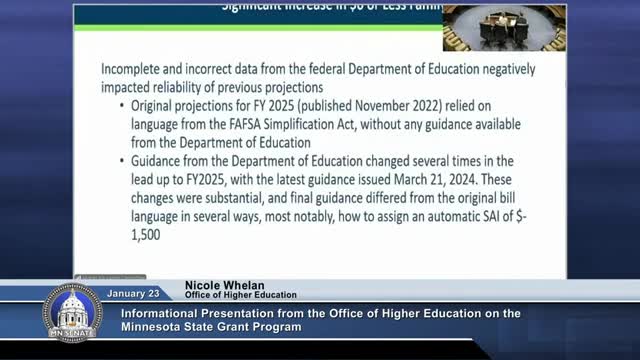State grant program faces $5 million deficit amid FAFSA changes and rising student need
January 24, 2025 | Higher Education, Senate, Committees, Legislative, Minnesota
This article was created by AI summarizing key points discussed. AI makes mistakes, so for full details and context, please refer to the video of the full meeting. Please report any errors so we can fix them. Report an error »

The Minnesota Senate's Committee on Higher Education convened on January 23, 2025, to address significant changes in state grant funding, primarily driven by recent modifications to the Free Application for Federal Student Aid (FAFSA). These changes have led to a notable increase in the number of students applying for state grants, particularly those demonstrating high financial need.
During the meeting, officials reported a dramatic shift in the financial profiles of applicants. In fiscal year 2024, just under 30% of applicants had a family Expected Family Contribution (EFC) of $0. This year, that figure has surged to 43%, with many students now showing a negative SAI (Student Aid Index) of up to -$1500. This increase in applicants with zero or negative contributions is straining the state's financial aid resources, leading to a projected deficit of approximately $5 million for the fiscal year 2025.
The committee discussed the implications of these changes, noting that the FAFSA simplification process has resulted in a broader range of students qualifying for aid, particularly those from families with an Adjusted Gross Income (AGI) below $100,000. The new formula has generally lowered expected contributions, thereby increasing the number of students classified as needy.
In response to the growing demand, the state has implemented measures to manage the deficit, including rationing awards and establishing a FAFSA deadline of December 1, 2024, for spring awards. However, officials acknowledged that some awards may not be funded this year, a situation described as "very rare" in the history of the state grant program.
The committee also explored how promotional programs like the Northstar Promise, which offers free tuition at certain institutions, may be influencing the number of applicants seeking state grants. As students navigate these funding opportunities, the interplay between state grants and federal aid programs continues to evolve, impacting the financial landscape for many Minnesota families.
As the committee prepares for the upcoming February projections report, the focus remains on addressing the funding challenges while ensuring that students in need receive the support necessary to pursue their education. The outcomes of these discussions will be crucial for shaping future policies and funding strategies in Minnesota's higher education system.
During the meeting, officials reported a dramatic shift in the financial profiles of applicants. In fiscal year 2024, just under 30% of applicants had a family Expected Family Contribution (EFC) of $0. This year, that figure has surged to 43%, with many students now showing a negative SAI (Student Aid Index) of up to -$1500. This increase in applicants with zero or negative contributions is straining the state's financial aid resources, leading to a projected deficit of approximately $5 million for the fiscal year 2025.
The committee discussed the implications of these changes, noting that the FAFSA simplification process has resulted in a broader range of students qualifying for aid, particularly those from families with an Adjusted Gross Income (AGI) below $100,000. The new formula has generally lowered expected contributions, thereby increasing the number of students classified as needy.
In response to the growing demand, the state has implemented measures to manage the deficit, including rationing awards and establishing a FAFSA deadline of December 1, 2024, for spring awards. However, officials acknowledged that some awards may not be funded this year, a situation described as "very rare" in the history of the state grant program.
The committee also explored how promotional programs like the Northstar Promise, which offers free tuition at certain institutions, may be influencing the number of applicants seeking state grants. As students navigate these funding opportunities, the interplay between state grants and federal aid programs continues to evolve, impacting the financial landscape for many Minnesota families.
As the committee prepares for the upcoming February projections report, the focus remains on addressing the funding challenges while ensuring that students in need receive the support necessary to pursue their education. The outcomes of these discussions will be crucial for shaping future policies and funding strategies in Minnesota's higher education system.
View full meeting
This article is based on a recent meeting—watch the full video and explore the complete transcript for deeper insights into the discussion.
View full meeting
